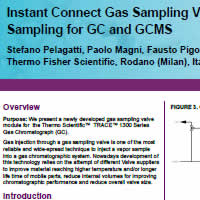Resumo do Pôster:
1. Introduction
Gas injection through a gas sampling valve is one of the most reliable and wide-spread technique to inject a vapour sample into a gas chromatographic system. Nowadays development of this technology relies on the attempt of different valve suppliers to improve material reaching higher temperature and/or longer life time of mobile parts, reduce internal volumes for improving chromatographic performance and reduce overall valve size.
On top of improved technical performance in terms of injection repeatability and stability, this work shows the simplicity and flexibility in configuration setting provided by an instant connect modular design. Without further hardware complexity the gas sampling valve module can be set to backflush to vent undesired part of sample, therefore offering an easy and integrated set-up for more complex analysis. Data showing performance of this solution are illustrated and discussed.
2. Purpose
Present a newly developed gas sampling valve module for Gas Chromatograph.
3. Method
All experiments described in this work use a GC equipped with a gas sampling valve (GSV) module as injection port and a thermal conductivity detector (TCD) module in series with a flame ionization detector (FID) module. Moreover, for the determination of nitrous oxide in air, an electron capture detector (ECD) module has been used.
The GSV module is provided with all the electronics and pneumatics built in the module, including the parts necessary for the backflush option. It is a thermostatted (up to 150 °C) 6 ports membrane valve with a constant purge of helium in order to avoid any possible air diffusion through the membrane, particularly critical when used in combination of oxygen sensitive detectors. The channels in contact with the sample are fully surface deactivated in order to prevent corrosion or absorption phenomena, especially for sulfur components at low concentration levels. Two charcoal filters, one on the carrier line and the other on the split line, can be replaced without any intervention on the valve connections. The performances of the GSV module have been evaluated using a certified gas mix with O2, H2, CH4, CO2, CO, N2 and He. The loop has been loaded in continuous way with gas mix through the “Sample in” port of the module with a flow of 5 mL/min. The sampling occurred automatically whenever the GC was ready to inject.
4. Results and Discussion
Examples of the chromatograms obtained with the FID and TCD are presented in Figure 1. The backflush valve was actuated after 1.6 minutes in order to avoid the entrance of CO2. The backflush time optimization requires few trials: it starts with an early reverse flow actuation; then the actuation start time is incremented until the last eluting peak before the undesired component is acquired in the chromatogram. The duration of sampling valve activation was 0.5 min, long enough to transfer completely the components from the loop into the column, considering the low dead volumes of the module.
The efficiency of the embedded backflush system has been tested using the same gas mix, but changing the backflush activation time (from 1.6 minutes to 1.4 minutes). The result highlights that a selective cut of the methane peak can be obtained, as shown in Figure 2.
The repeatability of peak areas, tested over 25 injections, was RSD <1% and demonstrates a good precision of the system. The repeatability of retention times for the analyzed gases was RSD <0.05% and shows a very stable pneumatic control.
5. Conclusion
The new GSV module, easily installable on the GC, has demonstrated to be a robust and reliable device for the detection and analysis of permanent gases or volatile compounds. The embedded backflush capability allows to protect the column from unwanted components, reducing the analysis time and preserving the column lifetime.
|

